Data Structures and Algorithms
- Introduction to Data Structures and Algorithms
- Time and Space Complexity Analysis
- Big-O, Big-Theta, and Big-Omega Notations
- Recursion and Backtracking
- Divide and Conquer Algorithm
- Dynamic Programming: Memoization vs. Tabulation
- Greedy Algorithms and Their Use Cases
- Understanding Arrays: Types and Operations
- Linear Search vs. Binary Search
- Sorting Algorithms: Bubble, Insertion, Selection, and Merge Sort
- QuickSort: Explanation and Implementation
- Heap Sort and Its Applications
- Counting Sort, Radix Sort, and Bucket Sort
- Hashing Techniques: Hash Tables and Collisions
- Open Addressing vs. Separate Chaining in Hashing
- DSA Questions for Beginners
- Advanced DSA Questions for Competitive Programming
- Top 10 DSA Questions to Crack Your Next Coding Test
- Top 50 DSA Questions Every Programmer Should Practice
- Top Atlassian DSA Interview Questions
- Top Amazon DSA Interview Questions
- Top Microsoft DSA Interview Questions
- Top Meta (Facebook) DSA Interview Questions
- Netflix DSA Interview Questions and Preparation Guide
- Top 20 DSA Interview Questions You Need to Know
- Top Uber DSA Interview Questions and Solutions
- Google DSA Interview Questions and How to Prepare
- Airbnb DSA Interview Questions and How to Solve Them
- Mobile App DSA Interview Questions and Solutions
DSA Interview Questions
- DSA Questions for Beginners
- Advanced DSA Questions for Competitive Programming
- Top 10 DSA Questions to Crack Your Next Coding Test
- Top 50 DSA Questions Every Programmer Should Practice
- Top Atlassian DSA Interview Questions
- Top Amazon DSA Interview Questions
- Top Microsoft DSA Interview Questions
- Top Meta (Facebook) DSA Interview Questions
- Netflix DSA Interview Questions and Preparation Guide
- Top 20 DSA Interview Questions You Need to Know
- Top Uber DSA Interview Questions and Solutions
- Google DSA Interview Questions and How to Prepare
- Airbnb DSA Interview Questions and How to Solve Them
- Mobile App DSA Interview Questions and Solutions
Data Structures and Algorithms
- Introduction to Data Structures and Algorithms
- Time and Space Complexity Analysis
- Big-O, Big-Theta, and Big-Omega Notations
- Recursion and Backtracking
- Divide and Conquer Algorithm
- Dynamic Programming: Memoization vs. Tabulation
- Greedy Algorithms and Their Use Cases
- Understanding Arrays: Types and Operations
- Linear Search vs. Binary Search
- Sorting Algorithms: Bubble, Insertion, Selection, and Merge Sort
- QuickSort: Explanation and Implementation
- Heap Sort and Its Applications
- Counting Sort, Radix Sort, and Bucket Sort
- Hashing Techniques: Hash Tables and Collisions
- Open Addressing vs. Separate Chaining in Hashing
- DSA Questions for Beginners
- Advanced DSA Questions for Competitive Programming
- Top 10 DSA Questions to Crack Your Next Coding Test
- Top 50 DSA Questions Every Programmer Should Practice
- Top Atlassian DSA Interview Questions
- Top Amazon DSA Interview Questions
- Top Microsoft DSA Interview Questions
- Top Meta (Facebook) DSA Interview Questions
- Netflix DSA Interview Questions and Preparation Guide
- Top 20 DSA Interview Questions You Need to Know
- Top Uber DSA Interview Questions and Solutions
- Google DSA Interview Questions and How to Prepare
- Airbnb DSA Interview Questions and How to Solve Them
- Mobile App DSA Interview Questions and Solutions
DSA Interview Questions
- DSA Questions for Beginners
- Advanced DSA Questions for Competitive Programming
- Top 10 DSA Questions to Crack Your Next Coding Test
- Top 50 DSA Questions Every Programmer Should Practice
- Top Atlassian DSA Interview Questions
- Top Amazon DSA Interview Questions
- Top Microsoft DSA Interview Questions
- Top Meta (Facebook) DSA Interview Questions
- Netflix DSA Interview Questions and Preparation Guide
- Top 20 DSA Interview Questions You Need to Know
- Top Uber DSA Interview Questions and Solutions
- Google DSA Interview Questions and How to Prepare
- Airbnb DSA Interview Questions and How to Solve Them
- Mobile App DSA Interview Questions and Solutions
Guide to Server-Side Rendering (SSR) vs Client-Side Rendering (CSR)
In modern web development, Server-Side Rendering (SSR) and Client-Side Rendering (CSR) are two core techniques used to display content to users. Understanding the differences between these two methods is crucial for developers, especially those preparing for technical interviews or aiming to optimize web performance, SEO, and user experience. This post dives deep into both SSR and CSR, comparing their pros and cons, providing performance insights, and offering guidance on choosing the best approach for your projects.
Want to enhance your skills with free courses? Sign up now for exclusive updates and free access to the latest development courses on Data Science, Web Development, and more.
What is Server-Side Rendering (SSR)?
Server-Side Rendering (SSR) refers to the process where the server generates HTML for the page, processes the necessary logic, and sends the fully rendered page to the browser. This ensures that when a user requests a page, they immediately receive a fully formed document ready to be displayed.
How SSR Works
- Initial Request: A user requests a web page by entering a URL in the browser.
- Server Rendering: The server processes the request, executes business logic, and generates the HTML document for that page.
- HTML Response: The server sends the pre-rendered HTML to the browser, reducing the initial load time.
- Page Displayed: The browser can display the fully rendered page immediately.
- Subsequent Interactivity: Once the initial HTML is rendered, JavaScript executes on the client-side to handle dynamic interactions.
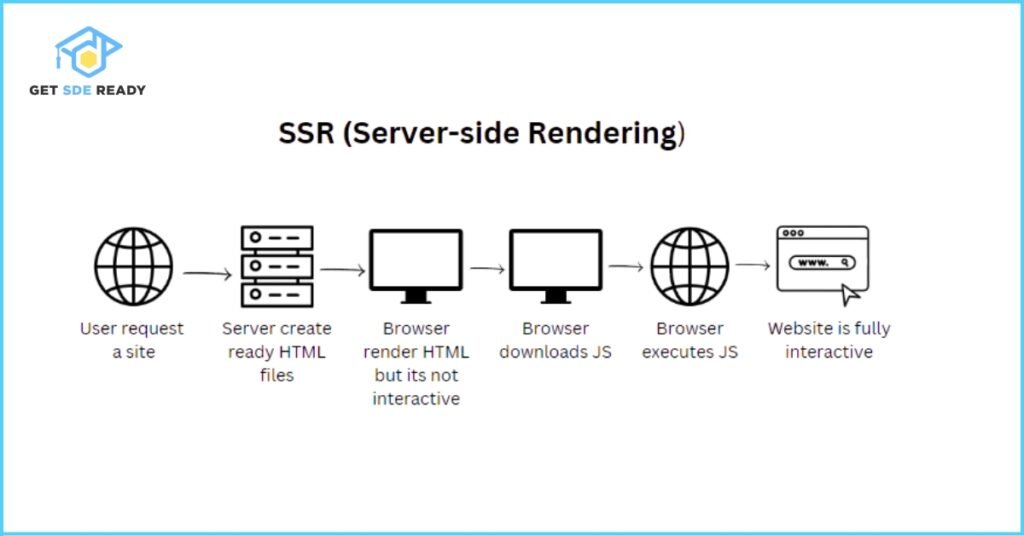
This process allows for content to be visible to the user almost immediately, improving the Time to First Byte (TTFB) and providing a smoother initial experience.
Advantages of SSR
- Faster Initial Page Load: Since the server sends pre-rendered HTML, the browser can display content faster without waiting for JavaScript to execute.
- Better SEO Performance: Fully rendered HTML is easily crawled and indexed by search engines, improving visibility on SERPs.
- Better for Static Content: Sites with content that doesn’t change frequently can benefit from SSR, as the server renders static pages efficiently.
- Improved Accessibility: SSR allows browsers to access content immediately, making websites more accessible to users with limited JavaScript or disabled scripting.
Disadvantages of SSR
- Higher Server Load: Every request results in a server-side rendering of the page, which can lead to performance bottlenecks under heavy traffic if not scaled appropriately.
- Longer TTFB: The server has to process the request and send back the rendered HTML, increasing the time it takes for the first byte to be received.
- Limited Interactivity: Since JavaScript execution happens after the page loads, SSR can result in less dynamic interactivity on initial load.
What is Client-Side Rendering (CSR)?
Client-Side Rendering (CSR) involves the server sending only the basic HTML structure along with JavaScript files to the browser. The browser then uses this JavaScript to dynamically render the page’s content on the client-side. This allows for a highly interactive experience after the initial load.
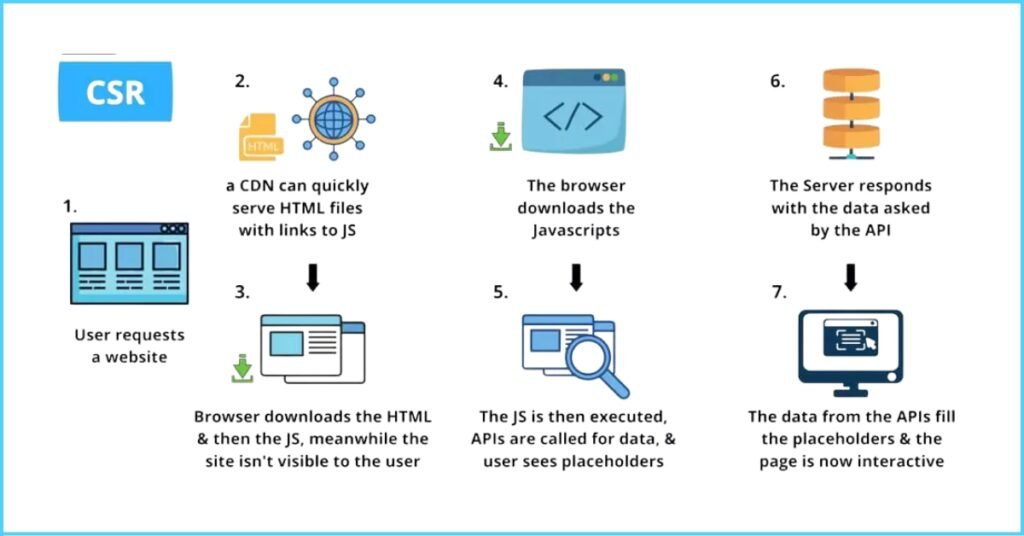
How CSR Works
- Initial Request: A user requests a web page by entering a URL in the browser.
- HTML and JavaScript Sent: The server sends a skeleton HTML page along with JavaScript files.
- JavaScript Execution: The browser executes the JavaScript, fetches additional content from APIs or databases, and dynamically renders the page.
- Page Displayed: After the JavaScript has run and fetched necessary data, the browser displays the fully rendered page.
- Subsequent Interactivity: The client-side JavaScript manages interactions, data fetching, and dynamic rendering, making the page highly responsive.
This method works well for single-page applications (SPAs) where the goal is to provide dynamic content with rich interactivity.
Advantages of CSR
- Reduced Server Load: Since the server only needs to send the initial skeleton HTML and JavaScript, the server load is significantly reduced.
- Dynamic User Experience: CSR enables dynamic page updates without requiring full page reloads, providing smoother transitions and real-time interactions.
- Faster Subsequent Loads: Once JavaScript is loaded, navigating between pages or views is much faster as only the required data is fetched rather than the entire page.
Disadvantages of CSR
- Slower Initial Load: The browser must download and execute JavaScript, which can delay the first render of the page.
- SEO Challenges: Search engines may struggle with rendering JavaScript-heavy pages, making it harder to index content unless prerendering or SSR is implemented for the initial load.
- Dependency on JavaScript: If a user has JavaScript disabled or if it fails to execute, the page may fail to render correctly, creating accessibility issues.
SSR vs CSR: A Detailed Comparison
1. Performance
- SSR: The initial page load is faster since the server sends pre-rendered HTML. However, higher server load and longer TTFB may affect overall performance if not well-optimized.
- CSR: The initial load can be slower due to the need for JavaScript execution, but subsequent navigation and interactions are faster since only the necessary data is loaded.
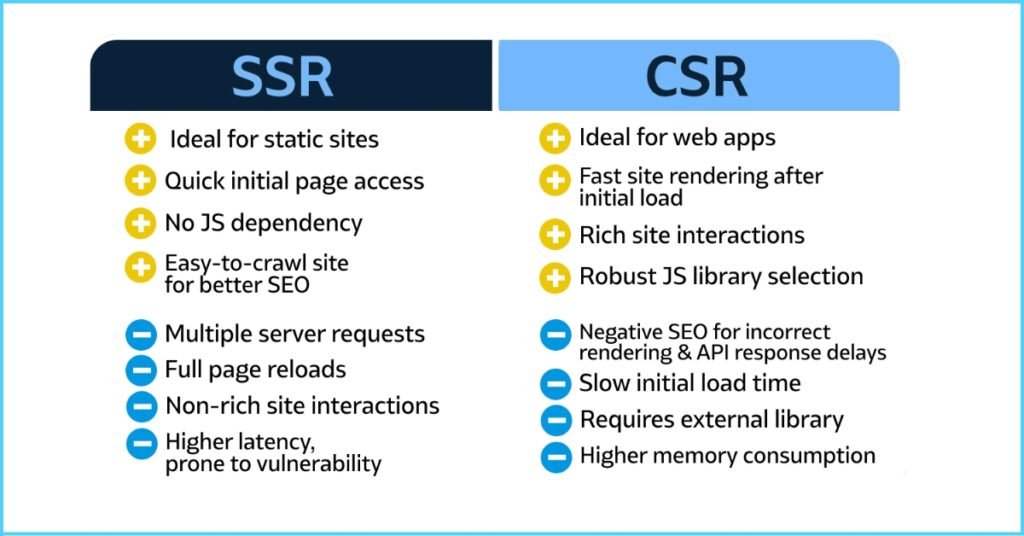
2. SEO
- SSR: Since the HTML is fully rendered by the server, search engines can easily crawl and index the content. This makes SSR ideal for SEO-friendly websites.
- CSR: Search engines may face difficulty indexing dynamic content rendered by JavaScript. To mitigate this, you may need to use prerendering or implement SSR for the first load.
3. User Experience
- SSR: Offers faster initial page load but may lack dynamic interactivity on the first render. JavaScript is required for full interactivity after the initial page load.
- CSR: Provides a more dynamic and interactive experience with real-time updates. However, the initial load may be slower as JavaScript needs to be executed first.
4. Development Complexity
- SSR: Generally requires more complex server-side logic and infrastructure. Frameworks like Next.js and Nuxt.js provide support for SSR with React and Vue.js, respectively.
- CSR: Easier to develop, especially for Single Page Applications (SPAs) that rely on frameworks like React, Angular, or Vue.js.
Hybrid Rendering: Best of Both Worlds
In modern web development, many applications use hybrid rendering, combining SSR for the initial load and CSR for subsequent interactions. This approach allows developers to take advantage of both SSR and CSR benefits, providing faster load times and better user interactivity.
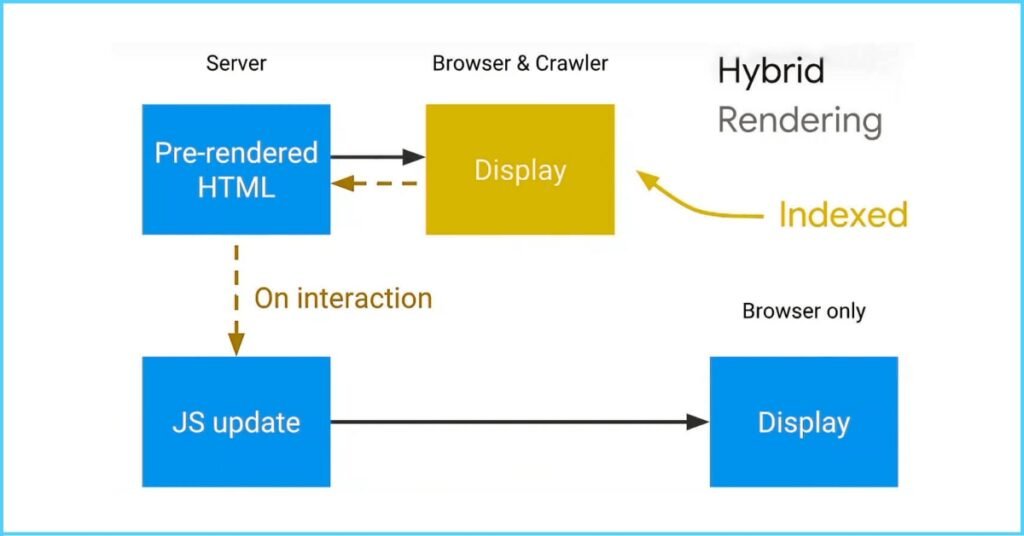
Benefits of Hybrid Rendering
- Faster Initial Load: SSR handles the first page load quickly, improving SEO and performance.
- Dynamic Interactivity: CSR kicks in after the first load to handle real-time updates and create a dynamic user experience.
- Flexible and Scalable: Hybrid rendering allows developers to choose the most appropriate rendering strategy for each page, balancing performance and interactivity.
Frameworks like Next.js (for React) and Nuxt.js (for Vue) make it easy to implement hybrid rendering by offering built-in support for SSR and CSR.
When to Use SSR and CSR
Use SSR When:
- SEO is a priority: Websites such as blogs, news sites, and eCommerce stores benefit from SSR, as search engines can easily crawl and index fully rendered HTML.
- Content is Static: Ideal for content-heavy websites where the content doesn’t change frequently.
- The First Interaction is Critical: Sites requiring a fast first interaction should consider SSR for quicker page rendering.
Use CSR When:
- Interactivity is Key: Applications like social media platforms, dashboards, or real-time apps benefit from CSR, as it enables a dynamic and engaging user interface.
- Frequent Content Updates: Highly dynamic applications where content changes frequently can leverage CSR for smoother transitions between pages.
- SEO is Less Important: If SEO is not a primary concern or if you are using prerendering strategies, CSR can be a better fit for highly interactive sites.
Conclusion
Both SSR and CSR have distinct advantages that cater to different types of applications. SSR excels in performance and SEO, making it suitable for static content and search-engine-friendly websites. CSR, on the other hand, offers a dynamic and rich user experience with less server overhead, ideal for real-time applications. Many modern projects combine both approaches through hybrid rendering to optimize both performance and user experience.
By understanding the strengths and weaknesses of SSR and CSR, developers can make informed decisions and build more efficient, user-friendly applications.
Want to sharpen your development skills further? Check out our advanced courses like Master DSA and Web Dev and Data Science to dive deeper into key concepts and frameworks.
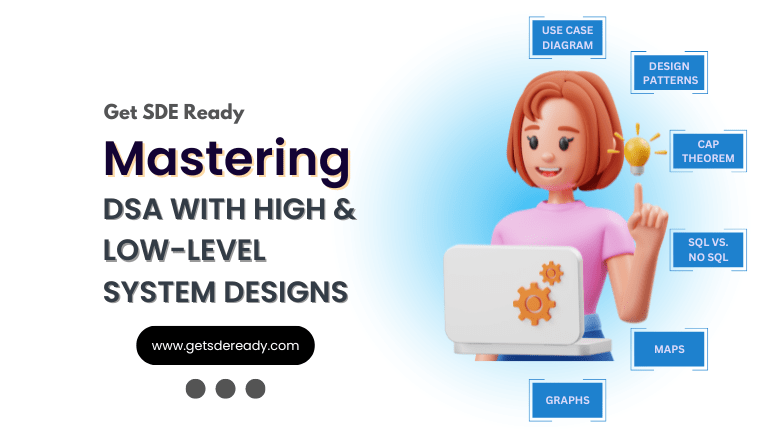
DSA, High & Low Level System Designs
- 85+ Live Classes & Recordings
- 24*7 Live Doubt Support
- 400+ DSA Practice Questions
- Comprehensive Notes
- HackerRank Tests & Quizzes
- Topic-wise Quizzes
- Case Studies
- Access to Global Peer Community
Buy for 52% OFF
₹25,000.00 ₹11,999.00
Accelerate your Path to a Product based Career
Boost your career or get hired at top product-based companies by joining our expertly crafted courses. Gain practical skills and real-world knowledge to help you succeed.
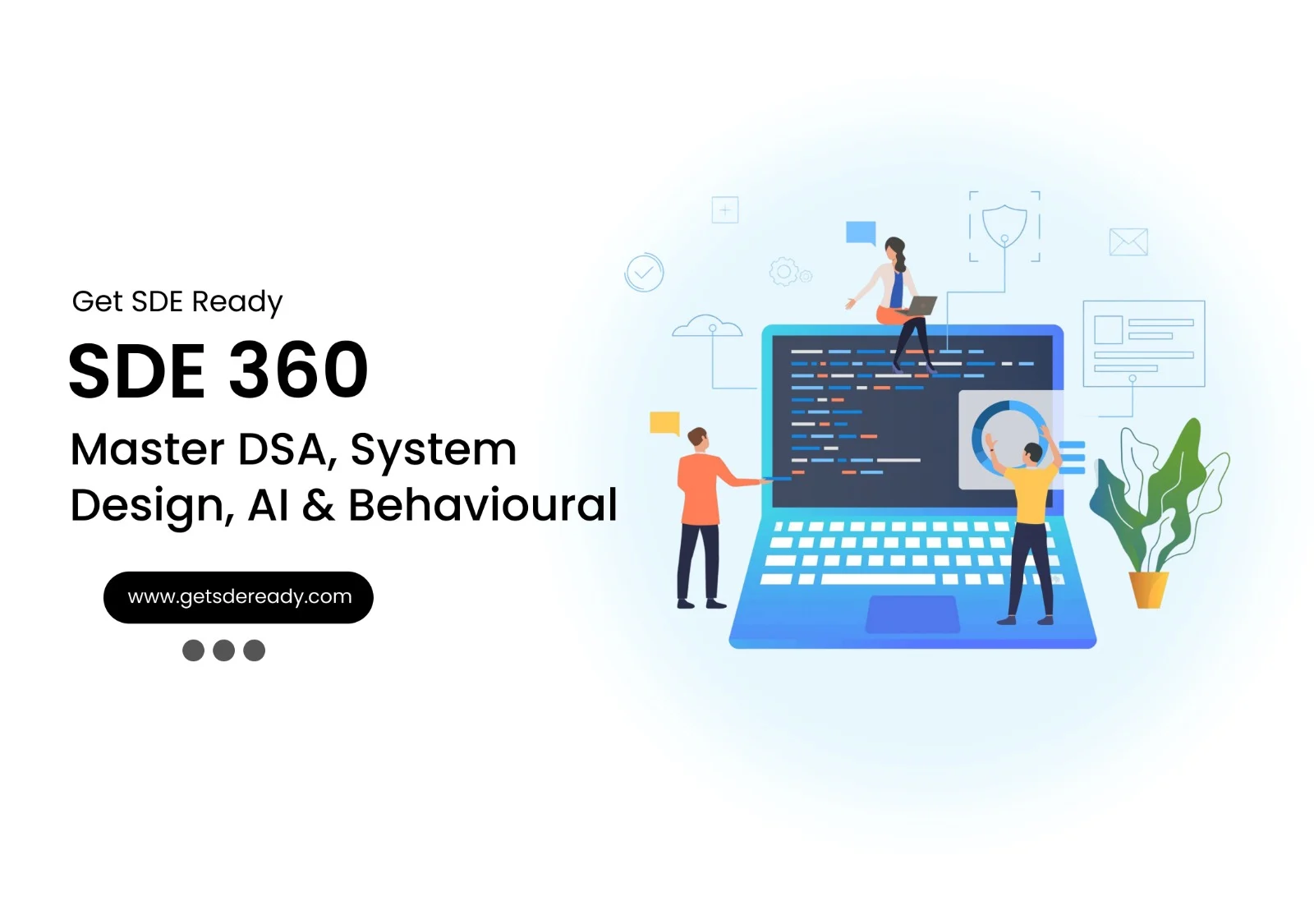
SDE 360: Master DSA, System Design, AI & Behavioural
- 100+ Live Classes & Recordings
- 24*7 Live Doubt Support
- 400+ DSA Practice Questions
- Comprehensive Notes
- HackerRank Tests & Quizzes
- Topic-wise Quizzes
- Case Studies
- Access to Global Peer Community
Buy for 50% OFF
₹39,999.00 ₹19,999.00

DSA, High & Low Level System Designs
- 85+ Live Classes & Recordings
- 24*7 Live Doubt Support
- 400+ DSA Practice Questions
- Comprehensive Notes
- HackerRank Tests & Quizzes
- Topic-wise Quizzes
- Case Studies
- Access to Global Peer Community
Buy for 52% OFF
₹25,000.00 ₹11,999.00
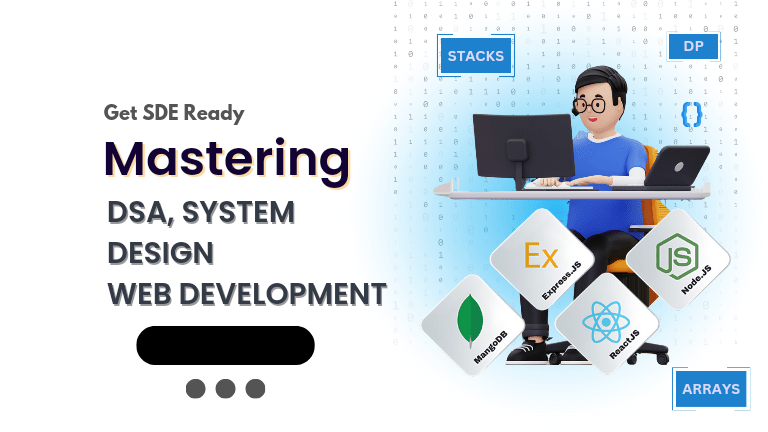
Fast-Track to Full Spectrum Software Engineering
- 120+ Live Classes & Recordings
- 24*7 Live Doubt Support
- 400+ DSA Practice Questions
- Comprehensive Notes
- HackerRank Tests & Quizzes
- 12+ live Projects & Deployments
- Case Studies
- Access to Global Peer Community
Buy for 51% OFF
₹35,000.00 ₹16,999.00

Low & High Level System Design
- 20+ Live Classes & Recordings
- 24*7 Live Doubt Support
- Case Studies
- Comprehensive Notes
- HackerRank Tests
- Topic-wise Quizzes
- Access to Global Peer Community
- Interview Prep Material
Buy for 60% OFF
₹20,000.00 ₹7,999.00
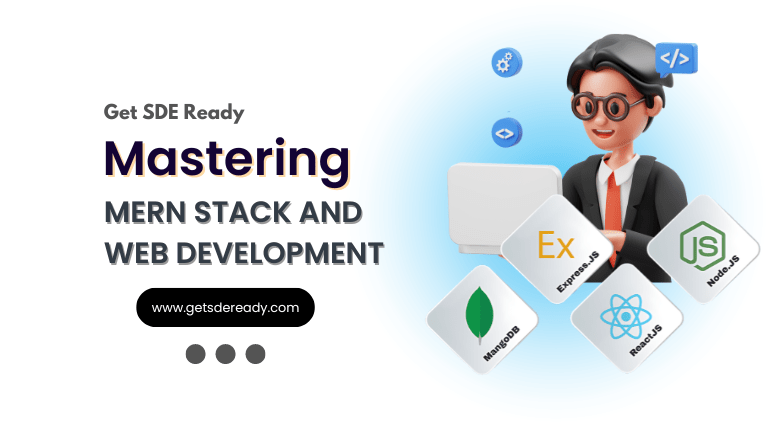
Mastering Mern Stack (WEB DEVELOPMENT)
- 65+ Live Classes & Recordings
- 24*7 Live Doubt Support
- 12+ Hands-on Live Projects & Deployments
- Comprehensive Notes & Quizzes
- Real-world Tools & Technologies
- Access to Global Peer Community
- Interview Prep Material
- Placement Assistance
Buy for 53% OFF
₹15,000.00 ₹6,999.00
Reach Out Now
If you have any queries, please fill out this form. We will surely reach out to you.
Contact Email
Reach us at the following email address.
arun@getsdeready.com
Phone Number
You can reach us by phone as well.
+91-97737 28034
Our Location
Rohini, Sector-3, Delhi-110085
